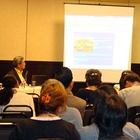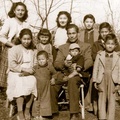Introduction
Japan gave impetus to begin migration when it ended the “sakoku” of three centuries, achieved rapprochement with other nations through the signing of Treaties of Friendship and Trade (Japan had signed such a treaty with Chile in 1897), and encouraged the “dekasegi” in order to alleviate, in part, the high social drama with which the bulk of the population lived. Under direct government auspices, thousands of families responded to the call and dispersed throughout the world in search of employment that Japan was unable to offer. Much of this official migration ended up in the Americas.
Not all countries, however, opened their doors. Among them was Chile. Despite its adverse reaction to immigration, a certain number of Japanese crossed its borders as free travelers, attracted to a quasi-mythical area on the other side of the world. Of these adventurous travelers, some ended their journeys and remained for awhile. A census count surprised some: the census of 1875 recorded the first two Japanese residing in Chile, and a decade later fifty-one Japanese were counted. The latter number was certainly surprising considering that Chile had fought a regional war with its neighbors, Peru and Bolivia, in 1879-1882. Undoubtedly, victory in war and the subsequent boom in the saltpeter market attracted adventurers from all over the world to Chile. Among the many people who came to Chile were a few Japanese. Who were these Japanese? Even today they continue to be unknown because they did not establish permanent roots. They soon realized that the little savings they had achieved was sufficient, and they returned to their families awaiting them in their native Japan.
Over time a few Japanese remained indefinitely, despite the lack of formal recognition of their presence. With an anonymous existence, they overcame loneliness, isolation, and foreign language and customs. Meanwhile, they searched for modest sources of employment throughout Chile because they became innocent victims of a government policy that favored the waves of European emigrants who had arrived in Chile to escape European wars and economic misery. To be sure, these Europeans had never experienced liberty in their home countries before; they were welcomed with friendly curiosity by a rural creole population.
Despite these difficulties, the census of 1907 counted 209 Japanese residing in Chile, five of whom were the first Japanese women to come to Chile. By 1940 the overall number of Japanese had increased to 948. The pacific theater of World War II (1941-1945) interrupted the migration, and we have to wait until the decade of the 1950s to see a new and spontaneous stream of migrants who brought with them other names, other dramas, and even other “kami .” Among them would be the “Nikkei” who honored their pioneer parents, as they carved niches for themselves in Chilean society.
The Rejection of Official Immigration
Its location and geography made Chile more of an island than part of South America; it experienced a spontaneous “sakoku ” until the nineteenth century. A rough mountain range isolates Chile on the east, and on the west an enormous ocean that is far from pacific. Toward the south Chile faces violent storms and frozen lands, and on its north side it has the driest desert in the world. The arrival of the Spanish conquistadors in 1536 facilitated mestizaje and, generally speaking, the birth of the Chilean people. At the same time, the process structured a creole culture to mirror the proper ways of life found in Spain and Europe. From this mixing emerged an official language (Spanish), religion (Catholicism), values, customs, a world view, tastes, and phobias. Among the phobias that emerged, a disdain for the indigenous and the ancestral, not to mention a lack of trust in anything that remained outside their cultural purview.
The emergent creole upper-class, proud of their recently acquired lineage, was determined to emulate European and Spanish models in particular. With the start of the nineteenth century, particularly the wars for independence (1810-1818), this dominant class was put in charge of the nascent republic. The physical dominance of Spain may have ended, but its presence continued to be felt through those descendants who dreamed of making Chile a stepchild of Europe reminiscent of what took place during the three centuries of colonial isolation.
With the signing of the Treaty of Friendship and Commerce, which established relations between Japan and several countries of the Americas (specifically with Chile in 1797), the official Japanese “dekasegi” began to arrive in South America. These initial steps were taken in response to the Chilean government’s desire to attract Japanese migrants; however, in the end they only faced a resounding and persistent rejection on the part of officials, politicians, and businessmen who responded blindly to their Europeanized representatives (only the white race is worthy).
From the first official pro-immigration steps taken by the “Transoceanic Migration Company” in 1904, an anti-immigrant campaign developed in opposition that remained active until the 1900s, even when the Japanese legation opened in 1909 and a warm welcome was given to Minister Eki Hioki. Although xenophobia quieted down for awhile, it did not go away. It reappeared even stronger during the Second World War (1939-1945) with punitive measures taken against the Japanese. Fortunately, the lies and hate failed to undermine the natural sympathy that the popular masses in Chile felt toward foreigners. Something similar occurred in 1957 as a result of a whaling concession that provoked strong debates in Congress and in the press. Finally, in 1959-1960 (now without public scandal), xenophobes derailed efforts by Ambassador Rokuzo Yaguchi to bring a hundred Japanese peasant families to the lands of Aysén.
Nevertheless, the second half of the twentieth century witnessed a new series of events. Diverse Japanese companies came to have much significance in the economic life of the country (particularly from 1954 onward). Moreover, the Japanese embassy reopened, while Japanese manufacturing began to enjoy preference, and individual emigrants searched for a place to make Chile their second home.
The Immigrant Reality
They arrived at the margin of whatever official protection was given. Alone, they used their own resources and were trying to find their way in the midst of a foreign language and customs. They came from different families and prefectures (only three prefectures did not have emigrants in Chile), and with little contact among them, they traversed Chile in distinct moments and places on the frontier. Within these emigrants, one could find the children of relatively well-to-do families, merchants, landed peasants, and military personnel, the “samurai ” with their ancient privileges. Some sailors also were part of this wave of emigrants; these men were official immigrants of neighboring countries who, at the end of their contracts, continued on to Chile as professionals who had been contracted to work. A little later, a small influx of these immigrants arrived who were called yobiyose .
A mix of sweetness and bitterness shaped their reality. The ‘sweetness’ was the triumphant echoes of the War of the Pacific (between Peru and Bolivia), Chile’s charitable neutrality during World War I, and the investment that facilitated the saltpeter boom. The ‘bitterness’ took the form of systematic waves of European emigrants who occupied the best jobs under favorable conditions. Another was the use of synthetic saltpeter that replaced natural saltpeter; soon exports fell precipitously, hurting labor and nortino towns. Inflation skyrocketed without any anticipation of how to prevent it, and the squander of resources was government policy. Misery became a way of life with the Great Depression of 1929, followed by the many vicissitudes that World War II brought when Chile was forced to side with the Allies.
The high standard of living that existed in the first quarter of the twentieth century was lost overnight. While copper began to take the place of saltpeter, it would take six long decades to see the emergence of new opportunities. The struggle for a secure livelihood was associated with sweat and tears. Although these Japanese emigrants had come from families that were not suffering back home in Japan, in Chile, despite their disproportionate worry about finding employment, they were able to situate themselves in the intermediate place within the Chilean middle class, with a small minority even reaching the upper-ranks of this Chilean middle class.
Geographic Dispersion and Diversity of Labor Sources
The 200 or so Japanese who arrived in the first decade of the twentieth century settled down in at least nine towns scattered along the 3000 kilometers of Chilean territory. A majority was concentrated in the saltpeter regions of the north, and in the center of the country. In 1920, the number had tripled but remained dispersed; these Japanese could be found in double the number of towns in Chile. Without doubt this dispersion can be explained because a) there were neither family ties nor a common purpose to unite them, b) employment was limited by an abundant European labor force, and the prevailing sentiment that supported it only worsened, and c) the passage of time made more acute the necessities that demanded prompt responses. These situations fostered a transhumance, or a back-and-forth movement that made good use of existing freedom and the exceptional Japanese capacity to dignify all work. Distance loses meaning. At the end of the 1930s, the little more than 900 Japanese who had arrived in Chile established their residences in twenty-three of the twenty-five provinces of Chile. These residences continued to have a temporary feel to them. In fact, almost all of the immigrants lived in more than one place and held more than one job.
Their occupations were quite diverse. They counted almost forty distinct occupations. Self-employment had the highest percentage (43%), with the job of barber or hairdresser enjoying special preference (30%). Commerce provided jobs to 24%, while the post of general employee 15%, and farming another 15%. The remaining 3% worked in various occupations. Self-employment took many forms: hat maker, dry cleaner, translator, masseur & masseuse, gardener, etc. Commerce was varied in its headings and levels, contributing noticeably to the dispersion of emigrants throughout Chile. Within agricultural employment, there were those who grew rice and other cereals, while other workers cultivated ornamental plants and flowers on a large scale. There also were farm laborers, poultry keepers, and beekeepers.
As a complementary antecedent, we can say that the Japanese who resided in the mining regions of Chile were not inclined to work in these extractive activities but rather preferred the commercial and service sectors. Fishing activities had few followers, and the little capital that did arrive in Chile by way of these Japanese emigrants was set aside for commerce and agriculture.
© 2008 Ariel Takeda






